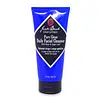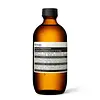What's inside
What's inside
 Key Ingredients
Key Ingredients

No key ingredients
 Benefits
Benefits

 Concerns
Concerns

 Ingredients Side-by-side
Ingredients Side-by-side

Water
Skin ConditioningSodium C14-16 Olefin Sulfonate
CleansingDisodium Cocoamphodiacetate
CleansingAloe Barbadensis Leaf Juice
Skin ConditioningCocamidopropyl Betaine
CleansingSodium Lauroyl Oat Amino Acids
CleansingGlycol Distearate
EmollientPEG-150 Distearate
EmulsifyingHamamelis Virginiana Extract
AntiseborrhoeicGlycerin
HumectantLavandula Angustifolia Extract
Skin ConditioningSalvia Officinalis Leaf Extract
CleansingMatricaria Recutita Flower Oil
PerfumingRosmarinus Officinalis Leaf Oil
MaskingSalvia Officinalis Leaf Oil
Lippia Citriodora Oil
PerfumingPEG-8 Dimethicone
EmulsifyingSodium Chloride
MaskingSodium PCA
HumectantCetyl Alcohol
EmollientCitric Acid
BufferingBenzyl Alcohol
PerfumingDehydroacetic Acid
PreservativeWater, Sodium C14-16 Olefin Sulfonate, Disodium Cocoamphodiacetate, Aloe Barbadensis Leaf Juice, Cocamidopropyl Betaine, Sodium Lauroyl Oat Amino Acids, Glycol Distearate, PEG-150 Distearate, Hamamelis Virginiana Extract, Glycerin, Lavandula Angustifolia Extract, Salvia Officinalis Leaf Extract, Matricaria Recutita Flower Oil, Rosmarinus Officinalis Leaf Oil, Salvia Officinalis Leaf Oil, Lippia Citriodora Oil, PEG-8 Dimethicone, Sodium Chloride, Sodium PCA, Cetyl Alcohol, Citric Acid, Benzyl Alcohol, Dehydroacetic Acid
Water
Skin ConditioningOlive Oil PEG-7 Esters
EmollientAmmonium Laureth Sulfate
CleansingGlycerin
HumectantPEG-150 Distearate
EmulsifyingAloe Barbadensis Leaf Juice
Skin ConditioningCitrus Aurantium Bergamia Fruit Oil
MaskingSea Salt
AbrasiveCoco-Betaine
CleansingRosmarinus Officinalis Leaf Oil
MaskingCamellia Sinensis Leaf Extract
AntimicrobialAnthemis Nobilis Flower Oil
MaskingMethylchloroisothiazolinone
PreservativeMethylisothiazolinone
PreservativeLimonene
PerfumingLinalool
PerfumingWater, Olive Oil PEG-7 Esters, Ammonium Laureth Sulfate, Glycerin, PEG-150 Distearate, Aloe Barbadensis Leaf Juice, Citrus Aurantium Bergamia Fruit Oil, Sea Salt, Coco-Betaine, Rosmarinus Officinalis Leaf Oil, Camellia Sinensis Leaf Extract, Anthemis Nobilis Flower Oil, Methylchloroisothiazolinone, Methylisothiazolinone, Limonene, Linalool
Ingredients Explained
These ingredients are found in both products.
Ingredients higher up in an ingredient list are typically present in a larger amount.
Aloe Barbadensis Leaf Juice comes from leaves of the aloe plant. Aloe Barbadensis Leaf Juice is best known for helping to soothe sunburns. It is also anti-inflammatory, moisturizing, antiseptic, and can help heal wounds.
Aloe is packed with good stuff including Vitamins A, C, and E. These vitamins are antioxidants, which help fight free-radicals and the damage they may cause. Free-radicals are molecules that may damage your skin cells, such as pollution.
Aloe Barbadensis Leaf Juice also contains sugars. These sugars come in the form of monosaccharides and polysaccharides, folic acid, and choline. These sugars are able to help bind moisture to skin.
It also contains minerals such as calcium, 12 anthraquinones, fatty acids, amino acids, and Vitamin B12.
Learn more about Aloe Barbadensis Leaf JuiceGlycerin is already naturally found in your skin. It helps moisturize and protect your skin.
A study from 2016 found glycerin to be more effective as a humectant than AHAs and hyaluronic acid.
As a humectant, it helps the skin stay hydrated by pulling moisture to your skin. The low molecular weight of glycerin allows it to pull moisture into the deeper layers of your skin.
Hydrated skin improves your skin barrier; Your skin barrier helps protect against irritants and bacteria.
Glycerin has also been found to have antimicrobial and antiviral properties. Due to these properties, glycerin is often used in wound and burn treatments.
In cosmetics, glycerin is usually derived from plants such as soybean or palm. However, it can also be sourced from animals, such as tallow or animal fat.
This ingredient is organic, colorless, odorless, and non-toxic.
Glycerin is the name for this ingredient in American English. British English uses Glycerol/Glycerine.
Learn more about GlycerinPeg-150 Distearate is an emulsifier and thickening agent. It is created from stearic acid.
As an emulsifier, peg-150 distearate helps other ingredients dissolve. This helps prevent ingredient separation.
This ingredient may not be Malassezia folliculitis, or fungal-acne safe.
Learn more about PEG-150 DistearateRosmarinus Officinalis Leaf Oil is oil expressed from the leaves of the rosemary plant.
Rosemary Leaf Oil is a fragrance and helps give your product a scent. If you are sensitive to irritating fragrances, this one contains camphor. Camphor has been found to irritate skin.
This oil also contains antioxidant and antimicrobial properties. As an antioxidant, it may protect you skin against damage. This can help slow down the signs of aging.
Learn more about Rosmarinus Officinalis Leaf OilWater. It's the most common cosmetic ingredient of all. You'll usually see it at the top of ingredient lists, meaning that it makes up the largest part of the product.
So why is it so popular? Water most often acts as a solvent - this means that it helps dissolve other ingredients into the formulation.
You'll also recognize water as that liquid we all need to stay alive. If you see this, drink a glass of water. Stay hydrated!
Learn more about Water